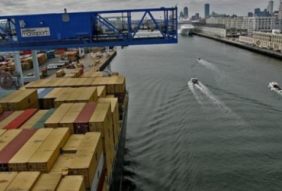
Posted on November 19, 2015
The Army Corps expected to deepen the Reserved Channel and other parts of the harbor by 7 feet to accommodate bigger ships. To ensure the power cable is safely out of the way of dredging equipment, the corps said it should be buried 60 feet below sea level. But right now, portions of the cable are not that deep, and Mike Keegan, a project management chief with the Army Corps, said it’s not inconceivable it could be snagged during dredging.
“What I’m worried about is whether or not it interferes with my project,” Keegan said. “If the cable isn’t laid right and it’s too close . . . it could be damaged by the [dredging] buckets,” Keegan said.
Eversource, the successor to both Boston Edison and NStar, has proposed protecting it with 1,000 feet of concrete “mats,” according to the lawsuit. In a separate proceeding before the Massachusetts Department of Public Utilities, an Eversource executive, John Moreira, said the utility was unable to get the MWRA to pay for the work. The MWRA said it was the utility’s fault the cable was not buried at the proper depth and that Eversource should foot the bill for protecting it during the dredging. It filed suit in Suffolk Superior Court in November to force the utility to pay.
The Deer Island treatment plant generates some of its own electricity from wind turbines, a small hydroelectric plant, and methane gas produced by processed waste, but the cable — whose copper armor is just six millimeters thick — is still “critically important,” Laskey said.
An Eversource spokesman said the company could not provide more information on the concrete mats. The company also believes the dispute with the MWRA should not be resolved in court but in the DPU proceeding.





